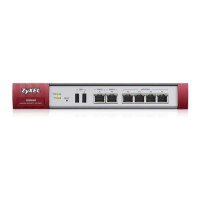Chapter 18 IPSec VPN
ZyWALL 5/35/70 Series User’s Guide
369
" It is not recommended to set a VPN rule’s local and remote network settings
both to 0.0.0.0 (any).
In most cases you should use virtual address mapping (see Section 18.6.2 on page 369) to
avoid overlapping local and remote network IP addresses. See Section 18.14 on page 385 for
how the ZyWALL handles overlapping local and remote network IP addresses.
18.6.2 Virtual Address Mapping
Virtual address mapping (NAT over IPSec) changes the source IP addresses of packets from
your local devices to virtual IP addresses before sending them through the VPN tunnel.
18.6.2.1 Avoiding Overlapping Local And Remote Network IP Addresses
If both IPSec routers support virtual address mapping, you can access devices on both
networks, even if their IP addresses overlap. You map the ZyWALL’s local network addresses
to virtual IP addresses and map the remote IPSec router’s local IP addresses to other (non-
overlapping) virtual IP addresses.
The following diagram shows an example of using virtual address mapping to avoid
overlapping local and remote IP addresses. You can set up virtual address mapping on both
IPSec routers to allow computers on network X to access network X and network Y computers
with the same IP address.
• You set ZyWALL A to change the source IP addresses of packets from local network X
(192.168.1.2 to 192.168.1.4) to virtual IP addresses 10.0.0.2 to 10.0.0.4 before sending
them through the VPN tunnel.
• You set ZyWALL B to change the source IP addresses of packets from the remote
network Y (192.168.1.2 to 192.168.1.27) to virtual IP addresses 172.21.2.2 to 172.21.2.27
before sending them through the VPN tunnel.
•On ZyWALL A, you specify 172.21.2.2 to 172.21.2.27 as the remote network. On
ZyWALL B, you specify 10.0.0.2 to 10.0.0.4 as the remote network.

